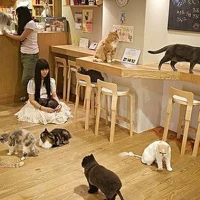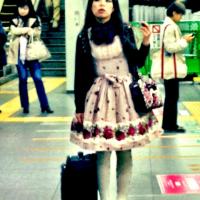(For an English translation, please scroll down)
Japanners hebben vaak veel moeite om in het Engels direct taalgebruik te hanteren.
In deze posting zal ik uitleggen waar dit vandaan komt.
Indirect of vaag zijn, noemt men in het Japans Aimai(na). Hoewel niet alle Japanners zich er zelfs maar bewust van zijn van hun gebruik van aimai, wordt het in Japan wel als deugt gezien. Het wordt zelfs verwacht dat je in Japan jezelf op een indirecte en vage manier uitdrukt. Helaas zorgt deze manier van communiceren er tegelijkertijd voor veel verwarring, niet alleen wanneer Japanners communiceren met niet Japanners, maar ook wanneer zij onderling communiceren.
De oorsprong van Aimai
de geografie heeft een sterke invloed gehad op veel van de gebruiken en culturele waarden in Japan. Omdat Japan een eiland is en de zee er omheen vaak gevaarlijk was en niet geschikt om (in kleine bootjes) de oversteek te wagen, heeft Japan jarenlang vrij weinig contact met de buitenwereld gehad en kon het een aantal aparte karakteristieken ontwikkelen.
Doordat Japan een veelal bergachtig landschap heeft leefden mensen vaak dicht op elkaar in kleine gemeenschappen. Iedereen kende elkaar, maar moest ook met elkaar door één deur kunnen. Het concept van harmonie of ‘wa’ werd geboren.
Het klimaat in Japan is ook van grote invloed geweest op hoe de mensen zich ontwikkelden. Het is er heet in de zomer, maar het regenseizoen vergemakkelijkt een intense vorm van landbouw zoals het verbouwen van rijst. Deze vorm van landbouw vereist veel werk wat één enkele man of vrouw vaak niet aankan. De irrigatie, het planten, het verzorgen van de rijst, dit zijn allemaal zaken die samenwerking vereisen wat veelal samen door één gemeenschap werd gedaan. Mensen werden daardoor gedwongen om met elkaar samen te werken omdat zonder de hulp van je buurman het niet mogelijk was om zelf een goede oogst te krijgen. Hierdoor kreeg je al snel een gevoel van unanimiteit of saamhorigheid. Omdat niet alleen de verbouwers van de rijst, maar ook de mensen die meehielpen afhankelijk waren van elkaar, wilden mensen niet uitgesloten (marahachibu genoemd) worden uit de groep en deden mensen er alles aan om maar geen ‘golven’ te maken of mensen voor het hoofd te stoten.
Als mensen zich opofferden en samen werkten voor het grotere doel van de groep, dan zorgde de groep ook dat zij niets te kort kwamen. Het groepsgevoel werd hierdoor alleen maar versterkt waardoor de persoonlijke mening steeds meer ondergeschikt raakte en de mening van de groep als geheel veel belangrijker werd.
Communicatie verliep vaker zonder iets te zeggen en er werd veelal naar de ouderen geluisterd voor hun advies en mening omdat zij nu eenmaal meer ervaring, wijsheid en macht hadden. Om de harmonie te bewaken, werd direct communiceren steeds vaker vermeden. Zelfs tot het niveau dat een simpel ‘ja’of ‘nee’ antwoorden niet meer mogelijk was. Als iemand wel ‘nee’ wilde zeggen, dan zei hij eerst niets en als het niet anders kon dan draaide hij er een beetje omheen en kwam met een ‘vaag’ antwoord wat negatief kon worden uitgelegd. Doordat al deze verschillende nuances de kans kregen om te ontwikkelen, werd Japans langzaam een taal waarbij één woord veel verschillende betekenissen kan hebben en er veel verschillende nuance verschillen zijn die hetzelfde in de basis betekenen.
Voorbeelden van indirect taalgebruik
Als je iets wilt weigeren in het Japans, dan gebruik je vaak woorden als ‘chotto, demo, kangaete-okune’ Niemand verwacht dat je direct zegt ‘ik hoef niet meer, ik vind het niet lekker of ik kan niet’. Mensen zijn bereid om ver te gaan om harmonie en een vriendelijke atmosfeer te waarborgen. Een van de meest bekende vormen van ‘aimaina kotoba’ (indirect taalgebruik) is de uitdrukking ‘ma-ma’. Dit wordt veel gebruikt in Japanse gesprekken. Dit betekent zoiets als ‘het gaat wel’, ‘niet slecht’ of ‘zozo’ afhankelijk van de context. Zelfs als iemand wordt gevraagd ‘hoe heb je je examen gedaan?’ Dan is het antwoord nog vaak: ‘ma-ma’. Als de persoon zou antwoorden dat hij of zij het goed had gedaan, dan zou deze persoon arrogant kunnen worden gezien, vandaar dat Japanners vaker zichzelf onderwaarderen om de persoon waar mee ze spreken niet voor het hoofd te stoten.
Verlegen
Veel mensen denken dat Japanners erg verlegen zijn. In veel gevallen heeft dit echter met beleefdheid te maken. Japanners hebben ook heus wel een eigen mening, maar ze spreken die vaak niet uit of geven de andere persoon eerst de kans om zijn of haar mening te geven. Als Japanners het ergens niet mee eens zijn, dan zullen ze eerst rustig luisteren en vervolgens niets zeggen of een vaag antwoord geven. In Japan als je tegen iemand ingaat of een negatieve atmosfeer creëert, dan loopt je het risico dat die persoon niets meer met je te maken wilt hebben. Japanners reageren over het algemeen emotioneel en zijn bang om buiten te worden gesloten uit een groep.
English:
Japanese often times have difficulty expressing themselfs directly in English.
In this posting I will explain where this stems from.
Being indirect of vague is aimai(na) in Japanese. Even though some Japanese are not aware of their use of aimai, it is seen as a virtue in Japan. It is even expected of you to express yourself in a vague and unobtruse way in Japan. Unfortunately this way of communicating often times leads to confusion and misunderstanding, not only when westerners and Japanese communicate together, but even among Japanese.
The origin of Aimai
The geographu of Japan has had a stong influence in the countries development of customs and cultural values. Because Japan is in island and the seas surrounding it are treacherous, it is not easy to be navigated by (small) vessels. This is why Japan was able to develop undisturbed by outside interfererence for many centuries and which is why so many idiocyncracies exist in the Japanese language and way of life that cannot be found anywhere else.
Because of the mountainous landschape in Japan, people lived together in close knit communities where everyone knew everyone and people knew each others business. Living so close together meant that harmony had to be maintained which is how the concept of ‘wa’ came into being.
The climate in Japan has also been an influence on how people developed. In Japan the summers are hot and humid and the rainy season allows for intense forms of agriculture such as the growing of rice. This form of agriculture cannot be done by one individual but needs the cooperation of many hands. The irrigation, the planting and harvesting of rice needs the cooperation of many people, which was often times done by the whole community. People were forced to work together because without help, a successful harvest could not be guaranteed. This created a feeling of togetherness. Since not only the growers of riced, but the people that helped were dependent on each other, people did not want to be ostracized from the community (called marahachibu). If people sacrificed themselves for the good of the community, then it provided and took care of them. This is why people did not want to create ‘waves’ or offend others. The ‘group mentality’ only grew under these conditions which meant that one individuals opinion no longer had any value but only the opinion as a community as a whole was paramount.
Communication changed and often times words were no longer necessary. Elders were usually consulted when decisions needed to be made as they had the most wisdom, experience and power. To maintain harmony, a direct form of communication was abandoned in favor of a more indirect way. Even to the level of not being able to respond with a simple ‘yes’ or ‘no’. If you wanted to say ‘no’, you would first simply say nothing and then proceed to say something vague with negative undertones in order to make it clear to the other party you’d disagree. Because all these different nuances had a place to grow and develop, the Japanese language has become very rich and one word can have many different meanings and there are many different nuance differences which basically all mean the same thing
Examples of indirect language use in Japanese
When you want to refuse something in Japanese, you often use phrases like ‘chotto, demo, kangaete-okune’ No one expects you to voice your opinion clearly by saying you dont want or need something, you don’t like something or you cannot do something. People will go far to maintain a sense of harmony and a friendly atmosphere. One of the most common forms of ‘aimaina kotoba’ (indirect language) is the ‘ma-ma’. This simple phrase is used a lot in Japanese conversations. It means something like ‘it’s okay’, ‘not bad’ or ‘soso’. Even when someone asks you:”How did you do on your exam?” You will most likely answer ‘ma-ma’. Even if you thought you’d ace dit, it is bad manners to say you think you did well or you run the risk of being thought of as arrogant or over confident. This is why Japanese tend to under value themselves when speaking about themselves in order not to offend anyone.
Shy
Many people think that Japanese are very shy. Generally speaking this has to do with good manners and being polite. Japanese often times do have an opinion of their own, but they either don’t metion this or allow for the other person to express their views first before giving their own opinion. If Japanese do not agree they will listen carefully, say nothing in return or give some kind of non committal answer that may have some negative undertones. In Japan when you flat out disagree with someone you run the risk of disrupting your relationship with the other person and perhaps lose that person as a friend or business partner. Japanese react from their emotions so they do not want to be cast out of the group and therefore strive to keep the peace.


























